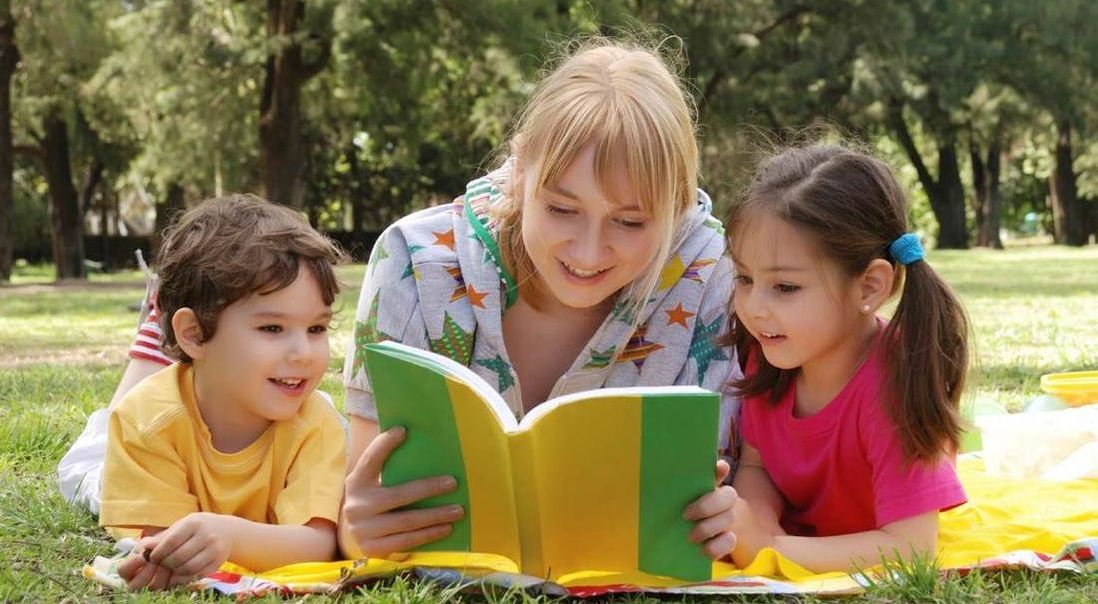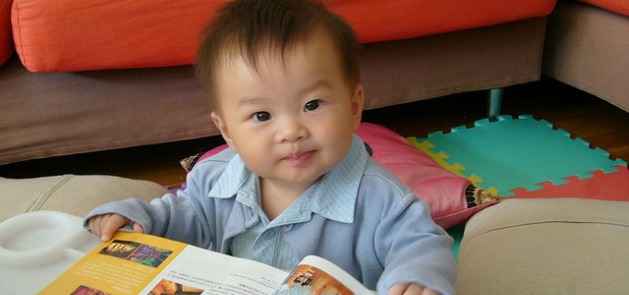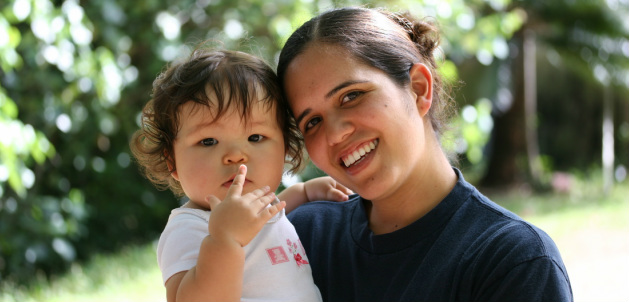|
Updated November 2023
Parenting is more than comforting children when they fall down, or making sure they get proper nutrition, and brush their teeth, and so on. Parents are responsible for their children’s spiritual training as well. You can constantly point a child towards the Lord, even from the time he or she is born, by talking to them about Jesus. You can pass a knowledge of the Bible on to them by daily using Bible story books and other devotional materials appropriate for their age. Following are some links to free online devotionals for toddlers, preschoolers and young children. These short, illustrated books, booklets and presentations will grab your little one’s attention and make him want to learn more about Jesus. Click on the links to either read these devotionals online or download them to your computer. Free Devotional Books: Big Thoughts for Little Minds – This series of five books brings key Bible passages to life in a relatable way for young children. The books include simple text, colorful illustrations and points for discussion to help little kids better understand Biblical principles. Click the following links to read or download the books for free: Jesus and Me – A series of books with messages from Jesus for children on themes such as: waking up, bedtime, kindness, healthy habits, learning new things, guardian angels, and protection. Click the following links to read or download these books for free: Seasonal Devotional Books – The following daily devotional books have been created for specific seasons:
Free Devotional Series: NEW! Thank God for the Seasons - Four short books with praises to God for the blessings of each season: In the Garden – A series of comics featuring a gardener and the children he works with. Children reading the booklets will learn valuable lessons about God’s love and care, kindness and consideration, obedience and the importance of spending time with Jesus each day. Coloring pages accompany the stories for added fun. Pray a Way – Colorful posters (with accompanying black and white pages to color) featuring rhyming prayers for just about every activity. A bible verse is included for each prayer. Topics covered include schooltime, mealtime, bedtime, holidays, grandparents and even pets. Bright Pebbles – Bright Pebbles is a collection of Christian and character-building books written for children ages four on up. Each devotional is built on a Bible verse, and explains to a child in simple terms what the principles of that verse mean and how it applies to daily living. The Bright Pebbles series is created by My Wonder Studio and there are currently over 85 of these devotionals posted online in pdf format for easy downloading. Additionally, a compilation of several books from this series can be downloaded for free in epub and mobi format. My Little Talks with Jesus – An ongoing series of short, devotional articles where Jesus talks with little children about day to day issues such as happiness, trying new things, forgiveness, going to sleep at night and more. This series is created by My Wonder Studio and all articles are in .pdf format for easy downloading. You can also download the ebook for free in epub or Kindle format. One Kind Deed at a Time – A series of ten devotional articles on the topic of kindness, consideration and forgiveness. Each devotional includes a Bible verse and practical ideas to put the article into action. This series is created by My Wonder Studio and all articles are in .pdf format for easy downloading. Through Every Day - Covers topics such as God's love, prayer, and kindness. A free coloring page accompanies every devotional. Basic Christian Principles for Little Children - Short devotionals to help children learn the basics of the Christian faith:
Other Free Devotionals for Little Kids
Devotionals from the Freekidstories Website - Freekidstories offers a range of free children’s devotional resources for babies, toddlers and preschoolers, including presentations of songs, illustrated simplified Bible verses and short devotional articles. Songs:
My Wonder Studio - The My Wonder Studio website is dedicated to creating free children’s stories, devotionals and activities that can be read online or downloaded at no charge. You can find materials for children ages 0-5 years here or check out stories and devotionals listed by category. Nurture, Inspire, Teach: Nurture, Inspire, Teach is a website dedicated to providing great online resources for children, teenagers and parents. Following are links to the site’s children’s devotionals for little ones.
To help your little one learn even more of God's Word, check out this list of free Bible stories online that your little ones are sure to enjoy. Some of these are available as PowerPoints while others are in .pdf and/or ebook format.
11 Comments
Families that share that common connection with God, whom the Bible calls love itself (1 John 4:8), are closer, more loving, more unified, and have far fewer serious problems among themselves than families that don’t. Why?—Because they have the most important things in common, besides a clear standard of right and wrong—the spiritual guidance and support they need to make the right decisions and stick to them. Click on the links for free illustrated and simplified Bible stories for children. Stories can either be read online or downloaded in .ppt or .pdf format. Bible Story Flashcards All flashcards can be downloaded for free (in .pdf format):
Bible Story Flannelgraphs These free Bible flannelgraphs cover stories from the life of Jesus, including the First Christmas, the healing of Jairus’ daughter, healing of the ten lepers, the parable of the lost sheep, the story of Zacchaeus and the story of the first Easter. All flannelgraphs can be downloaded in color or black and white. (.pdf format) Bible Story Presentations (PowerPoint) The following two sections contain Bible stories in PowerPoint presentation format; just right click an image and then select “save file as” or “save as” to download any Bible story onto your computer. Basic Old Testament Stories – Simple, colorful and nicely illustrated Old Testament stories for children. The stories found here include Creation, Noah and the Ark, Joseph, Moses, David and Goliath and Jonah. Basic New Testament Stories – New Testament stories found at this link include Jesus Calls 12 Disciples, The Good Samaritan, Jesus feeds 5,000, Jesus calms a storm, Jesus Heals a Blind Beggar, Lazarus lives again, The 10 Lepers, The Lost Sheep and The Prodigal Son. NEW! Old Testament Stories: (all stories can be read online or downloaded as a .pdf for free)
Life of Jesus (all stories can be read online or downloaded as a .pdf for free)
NEW! Parables of Jesus (all stories can be read online or downloaded as a .pdf for free) NEW! Stories of the Acts of the Apostles (all stories can be read online or downloaded as a .pdf for free)
Bible Story Books Some of these Bible story books can only be read online while others can be downloaded in .pdf, .epub or .mobi format.
Bible Passages and Prayers
Unless otherwise noted, all stories, flashcards, and coloring pages can be downloaded in .pdf format. Feel free to use them at home, church, or in other settings. Merry Christmas!
Christmas Stories and Books
Christmas Videos:
Christmas Coloring Pages and Activities:
It was a child who began the first Christmas celebration, and it is children who keep it alive in their own special ways. Christ manifests His presence in each child who celebrates His birth. May He also touch your life and home this Christmas. The first few months of your baby's life can be exhausting for both parent and child. Thankfully, most babies develop regular sleep patterns by the time they are 3 to 6 months old. In the meantime, try these tips for getting your little one to sleep through the night. Getting Immediate Relief
Transitioning to Sleeping through the Night
Establishing a Successful Routine
Text adapted from Wikihow.
Babies are one of nature's most perfect learning machines. With just a little insight, a baby can be stimulated and kept content. Starting early in your baby's development can do wonders for their mental growth in later years, and give them a large head start over other kids their age.
Tips and Warnings
Article courtesy of WikiHow.
Being a new mother, I wasn’t sure what to do with my baby girl, Arwen, for the whole day. She is an alert child, and was quite active even as a small baby. For a couple of months I would put her on my hip and take her around the house with me throughout the day, but before long that had me bored, and unfulfilled in my care of her. I was determined to ensure that my daughter would be smart and not behaviorally challenged. I read a few books on teaching children during what they call the “window of opportunity,” from ages 0-5. I was amazed to learn how parents can teach their children so many things, provided that they are consistent and use appealing methods. I began looking for materials with which to teach Arwen —flashcards, books, and other educational materials—and some materials I personally made. I started teaching Arwen when she was three months old. After my initial fervor died, and I wasn’t seeing much progress as a result of what I was teaching her, I found myself discouraged. It seemed that she wasn’t reacting to the "schooling" I was giving her. I figured that perhaps she was too young to be learning words, numbers, and other things that I was trying to teach her. However, I continued, and after a few months, I started noticing that she was responding positively to aspects of my teaching that she recognized, which I had repeated to her many times over. Then one day just before she was seven months, after having shown her flashcards for quite some time with no apparent results, I showed her the word “clap” and without me saying anything she clapped her hands. I was completely stunned. I had hoped my efforts would pay off, but actually witnessing her response was incredible, especially at such a young age. Arwen is my first child, so every new venture in her progress is a wonderful experience for me. Perhaps I won’t be in such a perpetual state of elation with my next children, but for me this sign of progress was an encouragement to keep teaching her new things. Now I try to turn everything into a learning experience. I’ve read that the best way to teach children, besides making learning fun, is to make their life a rich learning environment. And she expects me to! Every time I pass a poster or word that I have posted for her, she gets so excited and expects me to make a big deal out of it and explain it to her. Sometimes I worry that I can’t keep up with her learning capacity, but I’m willing to keep trying to the best of my ability. I’ve experimented with ways to teach her things and have started to write them down in my notebook, so as to remember them for when she’s older. Here are some teaching opportunities I’ve been taking with her daily:
With the things I teach Arwen, I try to make learning fun, so that in the future she’ll look forward to her schooling as opposed to dreading it. Sometimes, however, she is not in the mood to learn, and wants to play by herself, which is also a part of her development, so I’m cautious to not overdo, and make sure I give her times when I’m not teaching her, too. I hope these ideas can be helpful to other new moms who are maybe looking for ways to pour into their little ones while they’re still babies. Article courtesy of Motivated magazine. Used with permission.
Taken from Grow Up Reading
The developmental changes in babies from birth to 24 months are substantial and dramatic! At birth, babies rely on crying as their primary means of communicating and interacting with the world. As they grow, babies begin to use gestures, vocal and facial expressions, exclamations, babbling, and finally words to communicate with others. Good language skills help children grow into literate adults who can read and write proficiently. Parents can help babies become successful learners and readers by developing the following early literacy skills starting at birth. Oral language skills: Babies learn language in stages. During the first four months, babies are primarily on the receiving end of language. During the next four months, babies begin to initiate and imitate sounds. By eight months, a baby responds to her own name, distinguishes emotions by the tone of voice, responds to sound by making sounds and uses her voice to express joy and displeasure. By 12 months, a baby is paying increased attention to speech and responds to simple verbal commands. She is starting to use simple gestures such as waving “bye-bye” or shaking her head “no.” She babbles with inflection and uses exclamations such as “uh-oh,” and may say a few words such as “mama” and “dada.” One-year-olds can typically say six or seven words (although many speak none at all, while others might speak up to fifty) and understand close to seventy words. There is usually a five-month lag between a child’s understanding of words and his or her ability to speak them. Between 12 to 18 months, a child’s vocabulary slowly, but steadily increases. Most children’s vocabulary explodes once he or she can say about four dozen words. By the age of two, children typically learn the meaning of eight new words a day. The more parents talk and read to their baby, the more rapidly their baby’s vocabulary develops. According to early childhood experts, language skills grow faster in children whose parents use positive rather than negative feedback. Phonemic awareness: Being aware of phonemes—the smallest, unique sounds that make up words—is the basis for learning to speak and to read. Babies are quite skilled at detecting differences in sounds. This is why children are “wired” for learning multiple languages in the early years. Babies become aware of phonemes and learn to differentiate the sounds that make up speech through interactions with parents and other caregivers. Help your baby develop phonemic awareness by talking and reading to your child every day. Encourage your baby’s babbling, which helps him to learn language. At about two months, babies begin to coo, using vowel sounds like “aaah” and “oooh.” At five or six months, babies begin to practice sounds with consonants (b, d, j, m, n, and w are the most common). One-year-olds begin to combine vowel and consonant sounds into words. Comprehension: Comprehension is central to the process of reading. While comprehension is reinforced in the later years when an older toddler and preschooler can follow the pictures and text to understand the meaning of a story, it is important to talk about what is happening in the books you read aloud to your infant. According to Jim Trelease in The Read-Aloud Handbook, “Listening comprehension feeds reading comprehension.” As your baby listens to you read, point out clues about the story in the illustrations or relate a picture to something in your baby’s life. By using strategies like these, you stretch your baby’s thinking skills and encourage greater comprehension. Compiled from parenting.com
There’s nothing wrong with store-bought playthings, but here are fun, stimulating things you can do better: 1. Reinforce the “Aha!” Think of your baby as a budding scientist and watch for moments of revelation: the smile in the bath that means “Yes! I get the rubber duck when I’m in the water!” The waving arms that translate as “When Daddy makes that face, I’m going to be tickled!” Fulfill your infant’s simple expectations and share her joy at being right. 2. Hold your baby upright when he’s alert. Infants see most clearly when they’re vertical, not horizontal. So prop him up in your lap to show him new objects, and hold him up to look over your shoulder when you take him on a tour of his brand-new world. 3. Develop facial as well as verbal dialogues. Well before babies can even baby talk, you’ll see your infant attempt to replicate your facial expressions. Make different faces and watch how her interest perks up. “Listen” and respond to her expressions. 4. Rock ‘n’ roll. To satisfy your baby’s craving for motion, waltz him around the room, swing him gently to and fro, bounce him slowly up and down, sit in a swivel chair and see how he takes to a spin in your lap. 5. Encourage tasting. Think of her mouth as a sensuous space probe, gathering data about her personal cosmos. Avoiding objects too small, sharp, or grimy, let her lick that soup spoon, gum that cup, or chomp on a bread crust. 6. Read aloud. Don’t worry about “big words.” Nursery rhymes, books—the more variations in language a baby hears in his favorite voices, the more captivated he’ll be. Choose some books with lots of repetitive language, which babies like for their predictability. 7. Sing—with or without words. Forget the lyrics to your favorite lullaby? Hum it. Musical notes without all those consonants and vowels are a simpler and often more soothing form of stimulation.  Taken from Grow Up Reading (website) Emergent literacy: Use proper vocabulary when you talk to your baby. For example, say “toes” instead of “piggies.” This helps your child learn the rules of language with minimal confusion. Babies use gestures to communicate before they can talk. Encourage your baby to use simple gestures and signs (such as clapping for saying “please,” or touching their chest to say “thank you”), which can increase a baby’s understanding of language and accelerate language development. Help your baby hear the different sounds that make up words (phonemic awareness) by saying or singing nursery rhymes. Rhyming words share similar sounds—”dock” and “clock” in the classicHickory, Dickory, Dock, for example. Nursery rhymes place rhyming pairs of words in prominent positions to naturally draw a child’s attention to these sounds. By hearing pairs of rhyming words, babies begin to understand that words are made up of separate sounds, a critical reading skill. In addition to reading traditional picture books, use interactive books: books with flaps, textures, smells, and sounds to encourage exploration and stimulate your baby’s senses. Point to images on a page and name them; this helps increase vocabulary. Also talk about what is going on in the story; this helps develop comprehension skills. Use dialogic reading when you read aloud. The basic premise of dialogic reading is adults and children having a conversation about a book. Ask your baby “what” and “why” questions about the story, pause, and then answer your questions. Introducing this type of reading and questioning early will help your child become more comfortable with the process of dialogic reading when he or she is actually using words. Cognitive development: Play with toys that react, pop up, make noise or move to help your baby understand cause and effect. Between 9 to 12 months, most children will begin to play independently with toys and enjoy toys that react or make noise. Babies this age will begin exploring objects in many different ways (shaking, banging, throwing, and dropping) and begin to use objects correctly (shake a rattle, drink from a cup, listen to a phone). Play peek-a-boo games. Young babies have not developed a sense of object permanence—the understanding that unseen objects still exist. Start by hiding your face behind a blanket and then peeking out at baby. Put a scarf over your head and let your baby pull it off; hide objects underneath boxes and let your baby knock the box over to retrieve the object. Motor development: Give your baby plenty of freedom to move around on the floor. Young infants need to spend time on both their back and stomach in order to develop the muscles for the significant motor development that takes place in the first 15 months. Spending too much time in an infant swing or seat will hinder development of motor skills. Continue with lots of floor play as your child grows and begins crawling and walking. Add climbing challenges such as cushions, ramps, and tunnels to refine gross motor skills. Games that further develop hand-eye coordination and fine motor skills include building and knocking over block towers; covering and uncovering containers; taking toys apart and putting them back together again; picking up balls or objects in motion; turning knobs and pages of a book; scribbling and finger painting; and making shapes out of clay. Social and emotional development: Play finger and hand games like pat-a-cake and peek-a-boo; encourage your baby to imitate these gestures. Gesturing is a way babies communicate before talking. When you respond to your baby’s gestures, you reinforce his efforts to communicate. Sing songs with your baby. Music stimulates the cognitive and emotional areas of the brain. Encourage dramatic play through imitation of your actions in everyday activities—household chores, hobbies, entertaining, etc. Tell your baby what you are doing and prompt him to imitate you. Pretend play helps refine motor skills and foster a sense of accomplishment. Read books about daily routines such as brushing teeth, washing hands, putting on shoes, and taking a bath. These books encourage children as they prepare to learn and master these actions. Almost two centuries ago, men followed the events of Napoleon Bonaparte’s march of conquest across Europe, waiting with bated breath for any news of the outcome of his various wars. All the while, babies were being born in their own homes. But who could think about babies? Everybody was thinking about battles! However, in that one year, 1809, there came into the world several babies who were destined to become stars of the greatest magnitude—William Gladstone, considered by many as Britain’s greatest statesman of the 19th century; Abraham Lincoln, one of America’s most famous presidents; Alfred Lord Tennyson, the celebrated poet laureate of Britain; and the Frenchman Louis Braille, the blind inventor of the widely used Braille system of reading for the blind. While they were being born, no one thought of babies, just battles. Yet which of the battles of 1809 mattered more than the babies of 1809? Some fancy that God can manage His world only with big battalions, when all the while He is doing it by babies. Whenever a wrong needs righting or a truth needs preaching, God sends a baby into the world to do it. *** With all that there is to do in your busy lives, it’s sometimes easy to see your children as just one more thing you must take care of, and if you’re faced with a particularly hectic day, the simplest course of action can seem to be that of letting them entertain themselves with toys, videos, or games, while you take care of the business of the day. What you need to realize is that the love, concern, discipline, and attention that you fill up your child’s life with is what helps them to mature into the person they’ll become. If you are too busy to give your children the time and love that they need, you’ll miss out on one of life’s best investments; while you may meet other expectations of your day, those things will not live on eternally. It’s what you pour into your children that lives beyond today. You will always have work to take care of—the house to clean, a pile of clothes to launder, and bills to pay—but you won’t always have your children with you, and you won’t be able to regain the moments you lost “because you were too busy.” Every day, every moment, counts in helping to build your child’s future, and making them who they will become. Text copyright © TFI. |
Categories
All
Archives
March 2024
LinksFree Children's Stories |










 RSS Feed
RSS Feed
